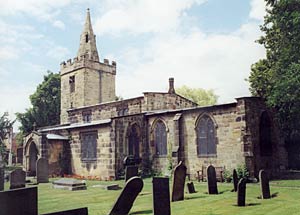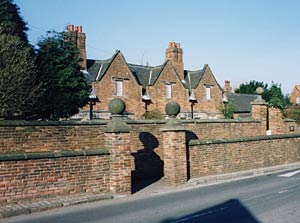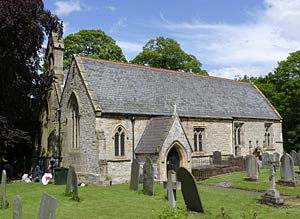< Previous | Contents | Next >
The Valour of John Shaw

Cossall church in 2003.

The Willoughby Almshouses, Cossall, in 2003.
COSSALL. They say the first coal in Notts was dug up in this border village seven centuries ago, and there are collieries still round about it, though the old village is in surprising seclusion on a green hilltop, looking to Ilkeston a mile away. It is a delightful picture as we come from Trowell, crowning a slope down which the canal winds like a serpent through the meadows.
Except for the 13th century tower and the low spire with dormer windows, the tiny church is not yet a centenarian, having been rebuilt in 1842. Under an arched recess in the sanctuary is a marble tomb of the Willoughbys, remembered for the fine almshouses near the church, founded by George Willoughby in 1685. In an aisle window is St Catherine in ancient glass. The bowl of the font is 15th century.
Cossall is proud of the great oak reredos, for its work was all done by village carvers. The cornice has roses, and among the fine bits of carving is a panel of passion flowers and leaves trailing over a cross, under a pinnacled canopy with a splendid finial.
It is strange to find in this little churchyard reminders of three wars. One is to 13 "lads of the village" who died for peace; another is to one who served all through the Crimean War; the third is a marble monument with helmet, cuirass, and crossed swords to three men who fought at Waterloo. Of these one lies buried here; the other two fell gloriously in the fight, and the daring deeds of valour of John Shaw the Lifeguardsman have given him a place among the brave for all time, and a lasting memory, in the words of Scott:
Nor 'mongst her humbler sons shall Shaw e'er die,
Immortal deeds defy mortality.
A giant of physical strength, it is said that he put out of action eight Frenchmen, refusing to retire from the field to have his wounds dressed, and only stopped fighting when he fell from sheer exhaustion. He was born in 1789 at a farmhouse.
A Saxon Fragment
COSTOCK. It is pleasant with cottages and farms, a little church in a narrow lane, and a charming Elizabethan manor house with a quaintly gabled roof, velvet lawns, a grand old chestnut tree, and a newel staircase made from a single oak. We were told that it was one of the first of its kind.

Costock church in 2014.
© Copyright Alan Murray-Rust and licensed for reuse under this Creative Commons Licence
What is old in the church is mainly 14th century, including the bowl of the font, but a lancet window is 13th, and the aisle and the porch are 19th. In a richly canopied recess in an outside wall lies the battered figure of a priest in robes; it is said that his head was knocked off by soldiers in the Civil War. Built into the wall near this recess is a lovely fragment of a Saxon preaching cross.
The church has what we may call a garden of poppyhead bench-ends, six of them 15th century, and over 60 the work of a rector who died just before the war. He was Charles Sutton Millard, and very good his work is, the ends well carved, and no two of all the poppy-heads alike. We may call them a garden because most of them are floral, but they have also quaint heads of animals, heads of men, and angels. One has trees of the forest and St Giles (the patron saint) with his hind.
The east window with the Crucifixion is in memory of the clever parson, and the east window of the aisle is in memory of nine men who did not come home again; in it are St George and St Michael, and Christ crowned.
